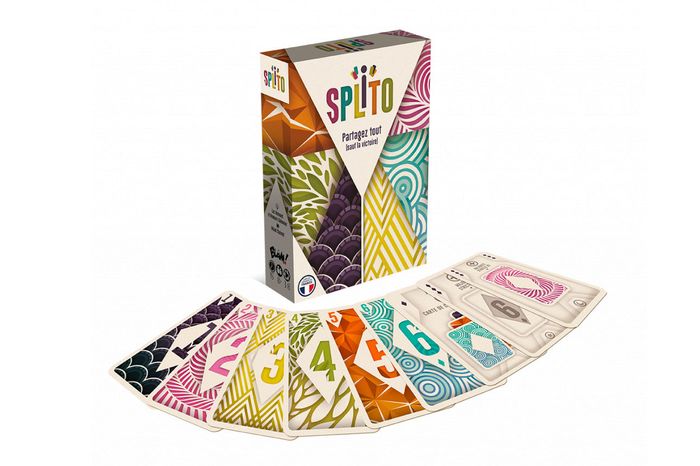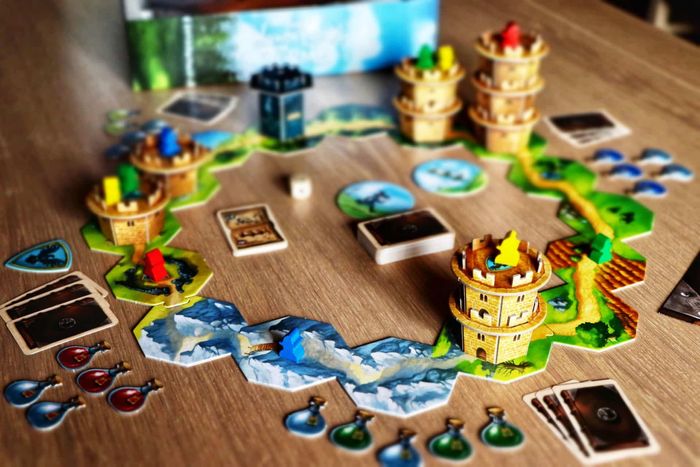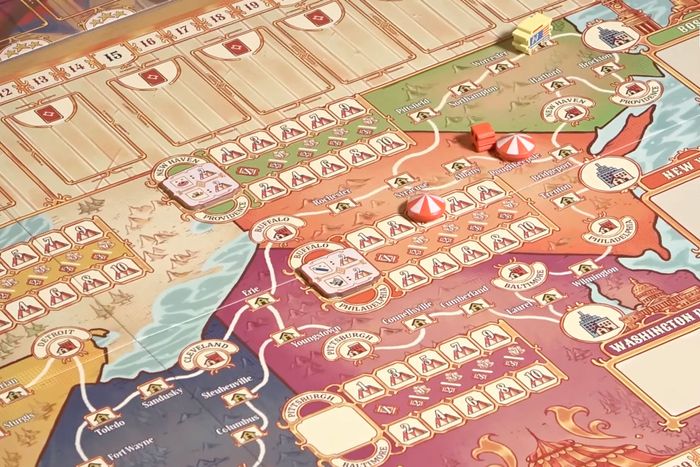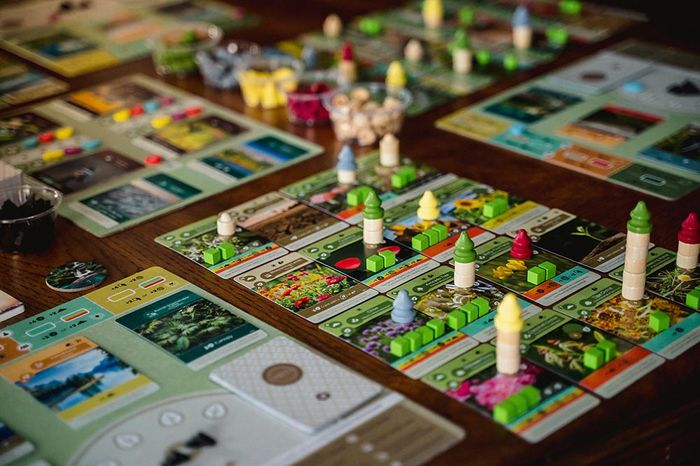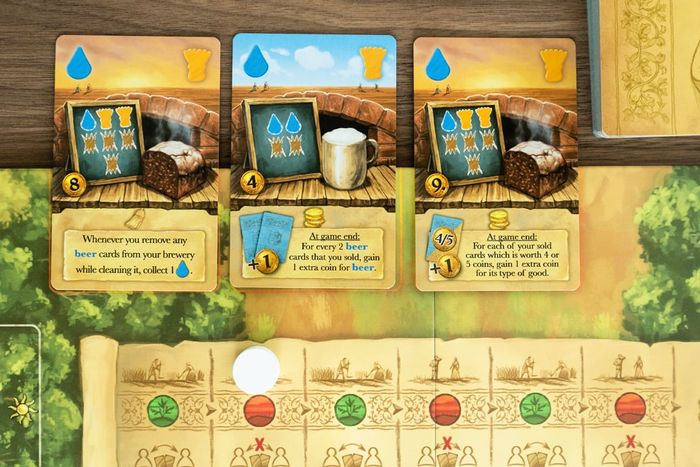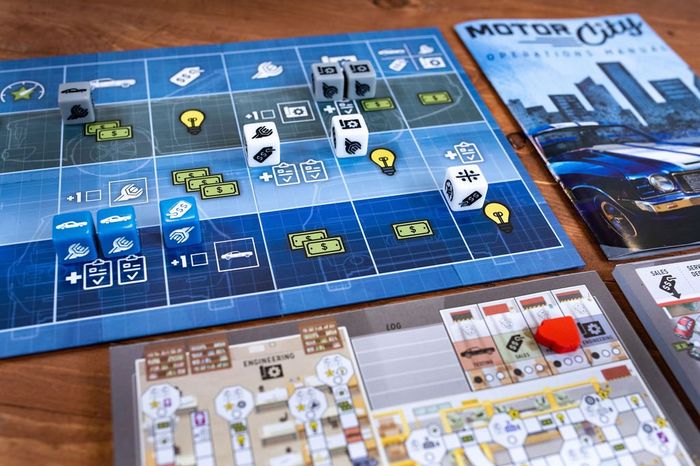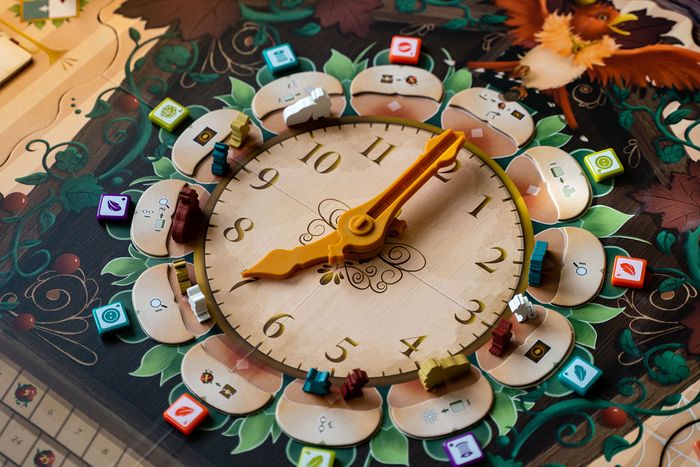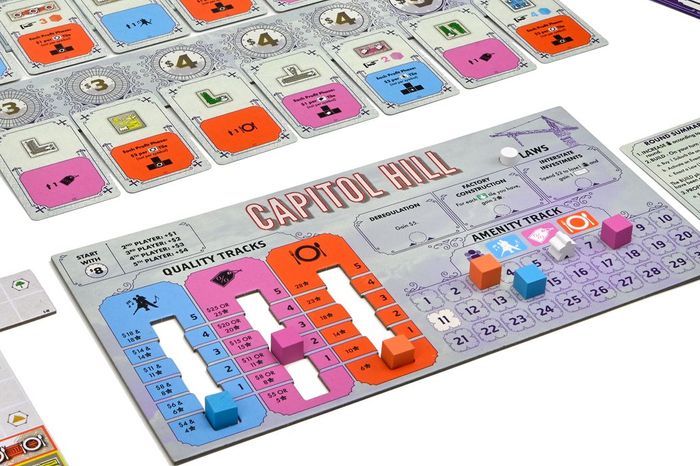
The holiday-shopping season is upon us, and I apologize if that sent a shiver up your spine, but in the board-game world it means a whole slew of new and upcoming releases as publishers try to get their newest titles into the channel in time for gift-buyers to splurge. This summer saw a big bump in releases and general interest in games; Gen Con, the largest tabletop convention in the western hemisphere, brought in a record 70,000 attendees who took over downtown Indianapolis for four days of gaming, with publishers selling out of many of their hottest titles.
Here are a few more of the best new titles from the summer, with many more on their way to retail as we speak, so even a month from now this list would probably look a bit different. Three of the four new entries are lighter family games, which adds some balance to a list from earlier this year that skewed toward the heavier or more complex titles.
Splito
Splito is a card game that plays like a party game, allowing for up to eight players at once without the intelligence-insulting aspects of most party games (yes, IÔÇÖm looking at you, Cards Against Humanity). In Splito, youÔÇÖre working with the players to your left and your right, but only in service of racking up the most points for yourself before the game is out. On each turn, you can play a card from your hand to either side, and at the end of the game, you and your neighbor will look at all of the cards between you ÔÇö scoring cards and numbered cards ÔÇö to see how many of those scoring cards you completed, with both of you getting the full point total shown if you did so. Those scoring cards might say you have to have a set of all six numerical values, or exactly two cards with the value of four, or no teal cards at all, referring just to the cards between you and that neighbor (not the other side). When the game ends, you take the product of your score from your left and the score from your right. It takes about 15-20 minutes to play and just a few minutes to learn; I played with eight people, ranging in age from 7 to 77, and everyone understood it while the player I would say is the least inclined to like board games ended up cleaning all of our clocks. (Hi, Mom.)
Applejack
Regular gamers might know the work of Applejack designer Uwe Rosenberg, most of whose games are either lighter works involving Tetris-shaped tiles (Patchwork, Cottage Garden) or heavier worker-placement games where you have to gather 8 billion different resources while making sure you have enough food (Agricola, A Feast for Odin). This tile-laying game is something entirely different, and it plays light until the rather intense scoring burst at the very end. One to four players compete to build the best apple orchard, building up different varieties of apples and placing valuable beehives between the trees. To do this, they place hexagonal tiles that show apples and/or flowers, with the apples coming in seven colors, trying to build chains of tiles that show apples in the same color to gain points. Where you place the tiles also matters for your honey┬á(thatÔÇÖs the currency you use to buy tiles), and you get it by lining up tiles with numbered beehives on their edges. There are two small scoring rounds during the game, but most of the points come in a big flourish at the end. You score double points for the final harvest, taking home two points for every apple in each chain that has more than three apples of its color, and can then get another bonus if you garnered points from at least four different colors. ItÔÇÖs a game that rewards balance while also introducing a puzzle element, and the turn counter keeps the game moving so that it can run as little as 30 minutes.
Wandering Towers
Wandering Towers came out in Germany last year but just appeared in the U.S. this summer in its first English version. ItÔÇÖs a great family game that has one of the cleverest and most hilarity-inducing mechanics IÔÇÖve seen in a while. YouÔÇÖre moving your wizards around the circular board to try to get them to the final tower, but it only counts if theyÔÇÖve filled their potion flasks first, and the way to do that is by moving the other towers around the board and trapping other playersÔÇÖ wizards beneath them. Your movement is restricted by the numbers shown on the cards you draw, but you have several wizards and towers you can move, and you can move your wizards on their own or let them scooch around the board by moving the tower on which your wizard is standing. The catch for the players whose wizards are trapped is that you canÔÇÖt peek under towers, so thereÔÇÖs a memory element here as well. ItÔÇÖs a hoot and a great game for the whole family, from the designers of Azul, Torres, and El Grande.
3 Ring Circus
I donÔÇÖt know why circus-building is suddenly a popular theme in board games, such as last yearÔÇÖs Tenpenny Park and this yearÔÇÖs light auction game Big Top, but it is, including this new medium-complex title from a pair of Italian designers. In 3 Ring Circus, players compete to build up their traveling circuses back in the heyday of the field, moving around the northeastern United States, putting on shows in small, medium, and large cities for income or points, while the big dogs of Barnum & Bailey move around behind them, awarding points to every player whoÔÇÖs already put on a show in the cities theyÔÇÖve visited. The way you gain performers and animals for your circus is novel ÔÇö they cost anywhere from $1 to $15 and you pay the cost difference between that performer and the highest valued one you already had in that row on your player board, so timing is, on the tabletop as in life, everything. The performer cards also have additional scoring opportunities and one-time bonuses, while you also gain additional bonuses by covering certain spots in the three rows on your board where you place the cards. The art is fanciful and the board is both appealing to look at and easy to understand, which helps with the various city types and different ways they score. ItÔÇÖs right in my personal wheelhouse for complexity level ÔÇö itÔÇÖs a thinker, but the cognitive load isnÔÇÖt so high that it starts to feel like work.
Earth
Earth is probably an early favorite to win one of the prestigious Spiel des Jahres (game of the year) awards this summer ÔÇö just like the game that clearly inspired it: Wingspan. While Wingspan has players using and reusing cards in an attempt to lure birds to their wildlife preserves, Earth ups the stakes with more cards, more actions, and more choices on every turn. Each of the one-to-five players in Earth will ÔÇ£PlantÔÇØ cards to their personal tableaux, which can grow to a four-by-four grid, or ÔÇ£WaterÔÇØ them, or ÔÇ£GrowÔÇØ them. Most cards in the game have an action written on them, and when any player chooses the appropriate main action, every player activates all cards theyÔÇÖve played that match it.
Like Wingspan, itÔÇÖs an engine builder, only Earth has more of just about everything, including a slew of different ways to gain points. The Plant cards you play are worth victory points, as are the sprouts and leaves that youÔÇÖll place on them through Grow and Water actions, and you can create a Compost pile by discarding cards through various actions, using those composted cards either to get other benefits during the game or for more points at game end. There are also four public objectives that players all race to meet, as the bonuses go down the more that players achieve them, and a private objective each player gets to start the game. The icons are a bit much to learn, but the game itself moves along quickly because players do most of their work simultaneously. ItÔÇÖs more complex than Wingspan, with a similar feel that makes it seem like a natural progression for folks who love that game and want something in the same vein.
Beer & Bread
Beer & Bread is a two-player game where players gather grain to ÔÇö wait for it ÔÇö brew beer and bake bread. ItÔÇÖs a resource-management game where everything is done through a deck of cards that each give the player three choices: gather resources, bake/brew, or play a tool. The first two vary by card, with bread or beer giving victory points in line with how many resources are required to make them, while the tool powers may let a player gather more resources, increase their resource storage (which is very limited to start the game), or gain more points at the end of the game. The most interesting part of Beer & Bread, however, is the different ÔÇ£yearsÔÇØ within the game, which alternate and have different rules for resources and card play. In Fruitful years, resources are more abundant and players will swap hands after each card play ÔÇö you start the round with five cards, play one, then give the remaining four to your opponent, and so forth. When the game ends, each player tabulates their total points from baking bread and their points from brewing beer. Their final score is the lower of the two ÔÇö so it turns out that man cannot win by bread alone.
Motor City
Motor City is the latest roll-and-write from the designer team behind the very successful Fleet: The Dice Game and last yearÔÇÖs delightful farming simulator Three Sisters. Roll-and-write games have seen a big surge in popularity in the last three years, in part because theyÔÇÖre familiar to most players (Yahtzee is one of the oldest and certainly best known) and in part because most roll-and-writes are quick to play and, like my younger stepdaughter, highly portable.
In Motor City, players are building automotive plants in the heyday of American cars. One player rolls a broad set of custom dice that show different actions on their faces, then all players take turns claiming dice and placing them on the main board for a second action, where all of these ÔÇ£actionsÔÇØ involve marking off one or more spaces on your personal scoresheets. Those sheets are highly linked with bonuses, so as you move up or around a track on one of those sheets, youÔÇÖll gain the power to check off other boxes somewhere else and can potentially chain them to turn the roll of one die into multiple checks. The game only goes eight rounds, but each player will get to use 24 dice over the course of the game, so you can get a lot done even in such a short time. I adored Three Sisters, so this is right in my wheelhouse, and I love the interconnected nature of the scoresheets and how it takes roll-and-write games to a higher level of strategy.
Hickory Dickory
DonÔÇÖt let the cutesy nursery-rhyme name or the adorable mouse-shaped player pieces fool you ÔÇö Hickory Dickory is kind of cutthroat, and those mice will fall off the clock whether you want them to or not. Each player has a set of mouse meeples of different sizes and sends them around the clock on a scavenger hunt for various items on their ÔÇ£hunt cards,ÔÇØ gaining points for fulfilling those cards while also placing some of those gained tokens on their personal boards to try to complete rows or columns for even bigger rewards.
The main mechanism here, and the reason you want to hide the sharp objects before you play, is a clock in the center of the game board that has spaces on the minute hand where all players can place their meeples ÔÇö but space is limited, and itÔÇÖs a FIFO (first in, first out) queue, so if you want to place one of your meeples on the minute hand, it goes to the back, pushing every meeple already on there forward. If thereÔÇÖs no room, someone falls off on to the current space. Each of the spaces around the clock offers different actions and different items to collect, but if youÔÇÖre bumped off the minute hand, you may end up on a space that doesnÔÇÖt help you. ThereÔÇÖs also a separate board with tracks that show the chain weights of the clock, and your meeple there can get you points if you take actions that let you move it up that track more quickly. Hickory Dickory offers worker placement, set collection, tile placement, and progress tracks, all things you might expect to see together in a heavy Euro game. ItÔÇÖs not to that level of difficulty, but Hickory Dickory does require a lot of strategy and planning as well as a willingness to cut a mouse if itÔÇÖll help you.
Rebuilding Seattle
No, this isnÔÇÖt a game about the earthquake thatÔÇÖs likely to drop Seattle into the sea this century but one about the Great Seattle Fire of 1889, which burned through 25 city blocks and damaged much of its transportation infrastructure. That fire led to a rapid reconstruction process that saw the cityÔÇÖs population soar, which Rebuilding Seattle uses as inspiration for its gameplay, with each player managing their own resurgent neighborhood in a game thatÔÇÖs part economic and part tile placement. Players buy buildings of different types and shapes from the central market, trying to fill out their personal grids, which they can also expand by adding suburb grids for more space. In each round, you gain population, add to your neighborhood, and then earn income based on the businesses youÔÇÖve attracted. There are also universal events that can change game conditions or create more opportunities for players, and players may even change the ÔÇ£lawsÔÇØ to their own benefit. The game can run up to two hours with a full five players, but itÔÇÖs not very complex to learn, a welcome trait in an economic game.
Votes for Women
Sister suffragette! This game, by first-time designer Tory Brown, puts players in the fight for womenÔÇÖs right to vote in the United States, with one player/side fighting to get Congress to pass the 19th Amendment and convince 36 of the states to ratify it while the other fights against the process. The game is mostly decided by the cards each side plays; cards can be used for their event text on them, to place cubes into various states to gain control of them, to gain buttons that can be used to obtain strategy cards or reroll dice, or to lobby Congress. The suffragist side needs to place six Congress tokens on the track on the board ÔÇö but the opposition can remove them via the same sorts of moves. Once the sixth Congress token is placed, Congress has passed the 19th Amendment, and any state with at least four of one sideÔÇÖs cubes is considered to have ratified or rejected it. The suffragists have to achieve their goals by the end of the sixth round, after which thereÔÇÖs a final phase to resolve any undecided states. ItÔÇÖs a two-player game at heart, but it includes rules to allow for team play for up to four players and two different solo modes. The box also comes with a historical supplement and numerous other documents to help interested players learn more about the true story of the womenÔÇÖs suffrage movement in the United States.


